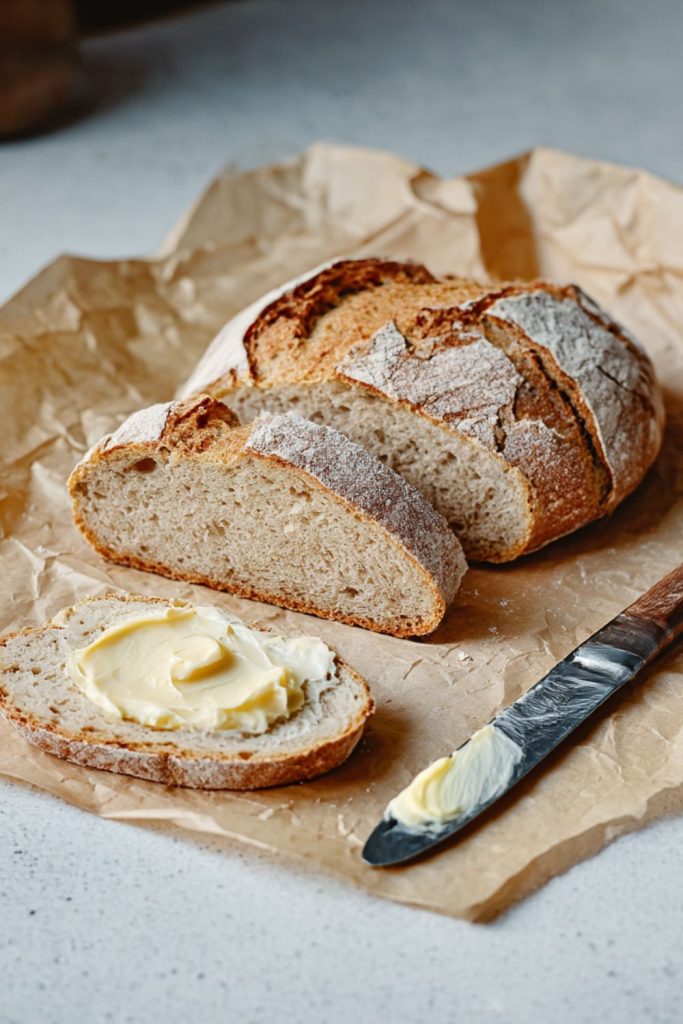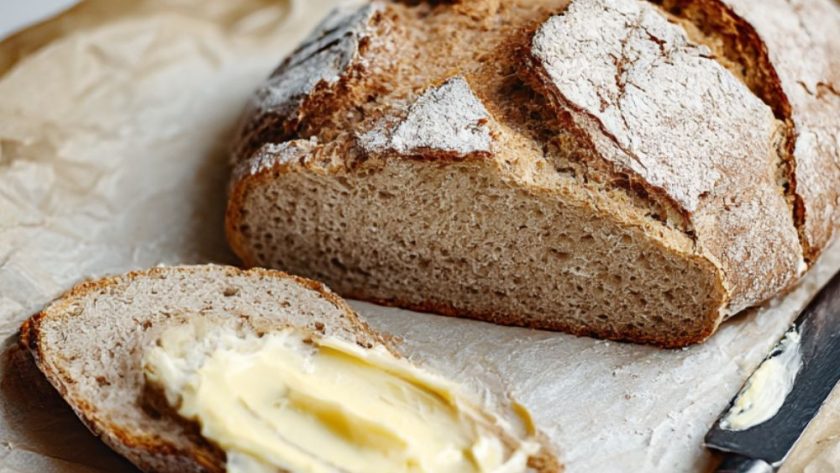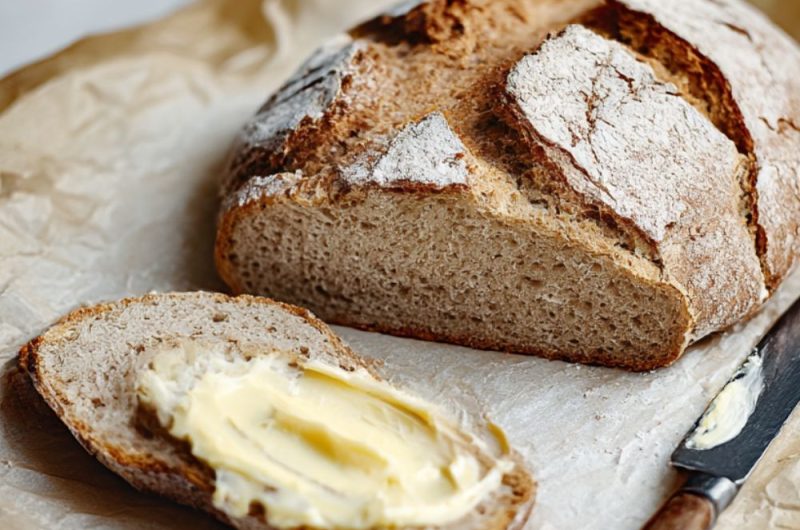This Gluten-free bread recipe is a soft and easy loaf, which is made with a gluten-free bread flour blend and yeast. It’s the perfect recipe for sandwiches and toast, ready in about an hour, plus rising time.
Gluten-free bread Ingredients
A simple list for a delicious and soft homemade loaf.
- 325ml semi-skimmed milk
- 2 large free-range eggs
- 1 teaspoon white wine vinegar
- 450g gluten-free brown bread flour blend
- ½ teaspoon sea salt
- 2 tablespoons golden caster sugar
- 1½ x 7g sachet of dried yeast (about 3¼ tsp)
- 3 tablespoons olive oil
How To Make Gluten-free bread
A step-by-step guide to this wonderfully simple and soft bread.
- Prepare the Wet Ingredients: Gently warm the milk in a small pan over a low heat, then let it cool slightly until it’s lukewarm. In a large bowl, crack the eggs, add the vinegar, and then gradually stir in the warm milk until combined.
- Combine the Dough: In another bowl, combine the gluten-free flour, salt, sugar, and yeast. Using a wooden spoon, stir the dry ingredients into the wet mixture until it forms a sticky dough. Add the olive oil and bring it all together with your hands into a ball.
- Prove the Dough: Place the dough onto a lightly oiled baking tray. Cover it with a damp tea towel and leave it to prove in a warm, draught-free place for about 1 hour, or until it has doubled in size.
- Bake and Cool: Towards the end of the proving time, preheat the oven to 200ºC/400ºF/gas 6. Once the dough has risen, place the tray in the hot oven and bake for around 35 minutes, or until the loaf is golden and cooked through. Let it cool on a wire cooling rack before slicing.

Recipe Tips
For a perfect, soft gluten-free loaf every time.
- Why is my gluten-free dough so sticky? Don’t be alarmed! Gluten-free dough is often much stickier and more batter-like than traditional wheat dough. It doesn’t have the gluten structure to become smooth and elastic. Resist the urge to add too much extra flour, as this will make your bread dry.
- What’s the best flour to use? It is crucial to use a pre-made “gluten-free bread flour” blend for this recipe. These blends are specifically formulated with a mix of alternative flours and a binder like xanthan gum, which is essential for creating the structure that gluten normally provides.
- How do I know my bread is cooked through? The most reliable test for any loaf of bread is to turn it over and give the bottom a firm tap. If it sounds hollow, it’s done. The top should also be a nice golden-brown color.
- Can I make this dairy-free? Yes, absolutely. Simply substitute the semi-skimmed milk with an equal amount of your favorite unsweetened, plant-based milk, such as almond, soy, or oat milk.
What To Serve With Gluten-free bread
Classic accompaniments for a fresh, homemade loaf.
This soft gluten-free bread is incredibly versatile. It’s perfect for:
- Serving with a hearty soup or a stew
- Toasting for breakfast and serving with butter and jam
- Making delicious sandwiches
- Serving with a platter of cheese and cold cuts
How To Store Gluten-free bread
Keeping your homemade loaf fresh.
- Room Temperature: Gluten-free bread is notorious for drying out faster than regular bread. Once completely cooled, it’s best to slice the loaf and store it in a well-sealed airtight container or a zip-top bag at room temperature. It’s at its best for 1-2 days.
- Toasting: Revive day-old slices by popping them in the toaster.
- Freeze: This bread freezes beautifully. Store the pre-sliced loaf in a freezer-safe bag. This way, you can just take out a slice and toast it from frozen whenever you want.
Gluten-free bread Nutrition Facts
An estimated guide per slice.
- Calories: 180 kcal
- Carbohydrates: 30 g
- Protein: 5 g
- Fat: 4 g
Nutrition information is estimated and may vary based on ingredients and cooking methods used.
FAQs
What does the vinegar do in this recipe?
The small amount of vinegar is a classic baker’s trick. The acid helps to create a better environment for the yeast to work in, and it also helps to strengthen the dough’s structure in the absence of gluten, resulting in a better rise and a softer crumb.
My bread didn’t rise. What went wrong?
There are a few common reasons. Your yeast might be old or expired. The u0022warmu0022 milk might have been too hot, which can kill the yeast, or too cold, which won’t activate it. Lastly, the spot you left it to prove in might have been too cold or draughty.
Can I bake this in a loaf pan?
Yes. For a more traditional sandwich-loaf shape, you can let the dough do its rise directly in a well-greased 900g (2lb) loaf pan.
Try More Recipes:
- Easy flatbreads Recipe
- Chilli cheese cornbread Recipe
- Italian tomato and bread salad (Panzanella) Recipe
Gluten-free bread Recipe
Course: Side DishCuisine: InternationalDifficulty: Easy14
servings15
minutes35
minutes180
kcalAn easy, foolproof recipe for a wonderfully soft and delicious homemade gluten-free bread loaf, perfect for sandwiches, toast, or serving with soup.
Ingredients
325ml semi-skimmed milk
2 large free-range eggs
1 tsp white wine vinegar
450g gluten-free brown bread flour blend
½ tsp sea salt
2 tbsp golden caster sugar
1½ x 7g sachet dried yeast
3 tbsp olive oil
Directions
- Gently warm the milk until lukewarm. In a large bowl, whisk the eggs and vinegar, then stir in the warm milk.
- In a separate bowl, combine the gluten-free bread flour, salt, sugar, and yeast.
- Stir the dry ingredients into the wet mixture to form a sticky dough. Add the olive oil and bring it together into a ball.
- Place the dough on a lightly oiled baking tray, cover with a damp tea towel, and let it rise in a warm place for about 1 hour, or until doubled in size.
- Preheat the oven to 200ºC/400ºF/gas 6.
- Bake the risen loaf for about 35 minutes, until golden and it sounds hollow when tapped on the bottom.
- Cool completely on a wire rack before slicing.
Notes
- Gluten-free dough is naturally much stickier than regular bread dough—this is normal.
- It is essential to use a “bread” specific gluten-free flour blend that contains a binder like xanthan gum.
- The vinegar helps to give the yeast a boost and improve the final texture of the bread.
- This bread is best sliced and stored in an airtight container to maintain its freshness.

